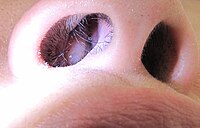
Photo from wikipedia
Introduction: The pathophysiology of Chronic Rhinosinusitis is coordinated by distinct inflammatory reactions in different individuals. Inflammatory environments with a predominance of Th2 lymphocytes tend also to be rich in eosinophils.… Click to show full abstract
Introduction: The pathophysiology of Chronic Rhinosinusitis is coordinated by distinct inflammatory reactions in different individuals. Inflammatory environments with a predominance of Th2 lymphocytes tend also to be rich in eosinophils. These environments are common during the formation of nasal polyps associated with aspirin intolerance, which is also marked by an increase in inflammatory mediators, especially IL-4, IL-5, and IL-13. Despite the significance of these inflammatory mediators, the relevance of IL-12 subunits' presence within eosinophilic nasal polyps, however, has been less studied. The current study aims to evaluate the presence of IL-12 subunits, IL-12p40 and IL-12p70, in eosinophilic nasal polyps and their correlations with IL-8 presence. Materials and Methods: We compared the concentrations of IL-8, IL12p40, and IL12p70 among samples of eosinophilic nasal polypoid tissue, eosinophilic nasal polypoid tissue associated with aspirin intolerance, and healthy nasal mucosa, using an indirect immunoassay (ELISA) kit. Results: When compared to healthy nasal mucosa, there was a lower concentration of IL-8 in Chronic Rhinosinusitis with Nasal Polyp (CRSwNP) tissue. Aspirin Intolerant polypoid tissue also presented a lower concentration of IL-12 subunits compared to healthy nasal mucosa. There was no significant correlation between IL-8 and IL-12 in the eosinophilic polypoid conditions. Conclusion: In CRSwNP, there is a reduction in IL-8 and IL-12 subunits compared to control, with a lack of correlation between IL-12 and IL-8. The lack of correlation can be justified by a type two inflammatory storm environment.
Journal Title: Iranian Journal of Otorhinolaryngology
Year Published: 2023
Link to full text (if available)
Share on Social Media: Sign Up to like & get
recommendations!